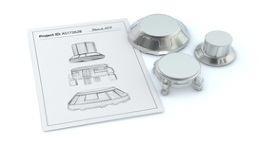Properties of Plastic
Plastics are generally low cost, easy to manufacture, durable, strong for their weight, electrically and thermally insulative, and resistant to shock, corrosion, chemicals, and water.
Types of Plastics:
Plastic materials include polypropylene (PP), polystyrene (PS), high impact polystyrene (HIPS), acrylonitrile butadiene styrene (ABS), polyethylene terephthalate (PET), polyester (PES), polyamides (PA) (Nylons), poly(vinyl chloride) (PVC), polyurethane (PU), polycarbonate (PC), and polyethylene (PE).
The name Plastic is derived from the Greek word plastikos, which means able to be shaped. Plastic materials consist of long chain molecules (polymers). Available in many colors and in transparent form, plastics can be rubbery or rigid. Plastic shapes include sheet, rod, hex, pipe, cubes, balls, and tubes.
Machining Options
CNC Milling
Mills use rotating tools to cut material into almost any 3D shape. CNC Mills can work with tight tolerances.
Waterjet Cutting
Waterjets mainly cut sheet material into 2D parts using a high-pressure stream of water and abrasive. Waterjet cutting is suitable for most materials and yields clean edges.
3D Printing
3D Printing (aka Rapid Prototyping) is an additive manufacturing process. It’s often used for testing designs and quick-turn low-volume 3D parts.
CNC Turning
CNC Lathes feed cutting tools into rotating material. Turning is mainly used to produce precise, cylindrical parts.
Injection Molding
Injection Molding produces parts by forcing molten polymer material into a mold. It’s the most economical process for producing high volumes of plastic parts.
Secondary Manufacturing
After manufacturing, parts may require additional processing. Secondary services include CNC bending, grinding, tapping, knurling and more.

Applications
Plastics are often used in appliances, auto interior panels, side shields, fender liners, head liners, CD and cassette boxes, displays, electrical connectors, electronic enclosures, eyeglasses, ID cards, instrument panels, lenses, name tags, outdoor signs, packaging, pallets, pipes, seat backs, security shields, shutters, window frames, windows and windshields.




